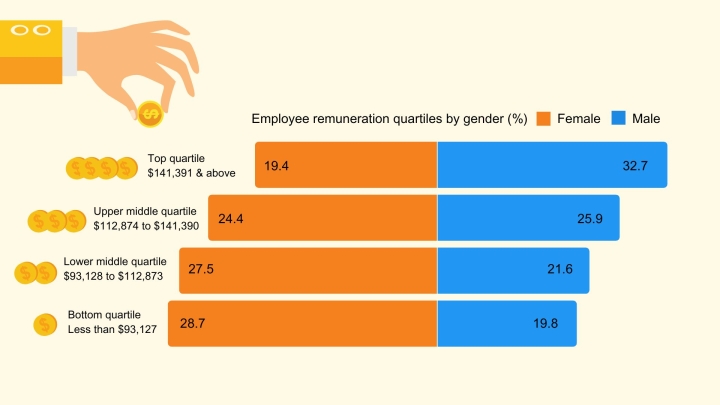The 2022 Commonwealth Public Sector Gender Equality Snapshot is the first look at WGEA reporting of gender equality in the public sector.
The 2022, Anti‑Discrimination and Human Rights Legislation Amendment (Respect at Work) Act resulted in an amendment to the Workplace Gender Equality Act 2012 to require Commonwealth entities and companies with 100 or more employees to report to WGEA from 2023.
Ahead of mandatory reporting WGEA invited relevant Commonwealth entities and companies to voluntarily report their gender equality data. 52 (of a possible 112) participated in this program. Participants included 40 agencies who employ staff under the Public Service Act (APS agencies) and 12 non-APS agencies
The data included in the 2022 Public Sector Gender Equality Snapshot reflects these voluntary reporting Commonwealth public sector employers. It does not reflect the public sector as a whole.
The full list of Commonwealth public sector employers that voluntarily provided data to WGEA can be found below.
Download the Public Sector Snapshot
Commonwealth Public Sector Gender Equality Snapshot 2022
Public Sector Snapshot Q&A 2022
Key findings at a glance
The public sector gender pay gap: Women, on average, earn 88 cents for every dollar earned by a man
- The total remuneration gender pay gap for the Commonwealth employers that voluntarily reported to WGEA is 11.6%
- Non-APS employers had a higher gender pay gap (13%) than APS employers (7.2%).
- 65% of employers had a gender pay gap in favour of men (a gender pay gap >5%).
- No employers had a gender pay gap in favour of women (a gender pay gap <5%).
WGEA’s gender pay gap includes total remuneration (salary, super, overtime, bonuses) and annualised full-time equivalent part-time workers’ earnings for comparability.
Workforce composition: Men are more likely to be in the top salary bracket and roles
- 1 in 3 men are in the top income bracket compared to 1 in 5 women.
- Women are 1.5 times as likely to be in the lowest earning quartile.
- Women make up 57% of the workforce in the Commonwealth Public Sector employers that voluntarily reported to WGEA. But women only hold 48% of leadership positions at the senior executive service level.
Action on gender equality: Employer targets largely focus on women
- 67% of the voluntary reporting public sector employers said they had set targets to improve workplace gender equality.
- Targets to increase the number of women in leadership (40%) and the number of women in male-dominated roles (19%) were most common.
- Far fewer employers are setting targets that focus on men, such increasing the number of men in female-dominated roles (4%) and using flexible work arrangements or taking parental leave (10%).
Support for carers: Men aren’t taking advantage of parental leave policies
- All reporting employers offered paid parental leave in addition to government-funded parental leave.
- The average length of primary carer’s leave is 15.4 weeks - more leave than the minimum set out in the Maternity Leave Act.
- Men account for just 13.5% of primary carer’s leave taken. This is similar to men’s uptake rates in the private sector (13%).
Consultation: Employers are consulting staff on gender equality
- More than 80% of employers reported consulting with employees on issues concerning workplace gender equality.
- This is despite most employers (67%) not having a formal policy on consultation.
Participating Commonwealth Employers
Scroll through to see all the employers that participated in the 2022 Public Sector Gender Equality Snapshot.
Public sector reporting in 2023
2023 public sector reporting dates are 1 September to 31 October for the 2022 year.
For more information on this process, head to the WGEA reporting portal.
More data and information
Get the latest data on gender equality in the private sector.
All the latest statistics on Australia's gender pay gap, including gaps by state and industry.
The complete guide to Commonwealth Public Sector reporting.

